There is a fascinating variety of birds that start with M in the dynamic field of ornithology. These feathery wonders decorate the skies and provoke awe and mystery like lovely notes in nature’s symphony. These birds live in many settings and exhibit a variety of colors, forms, and habits, from the majestic soar of the Marabou stork to the rapid swoop of the Merlin falcon. Let’s take a look at some enchanting birds that start with M, including the fastest and largest of this group of birds.
10 Birds That Start with M
1. Mallard
Classification: Anas platyrhynchos
One intriguing and distinctive bird that may be seen all around the United States is the mallard. It is a medium-sized duck with a length of around 20 to 25 inches and a wingspan of roughly 32 to 39 inches.
Mallard males, sometimes referred to as drakes, have colorful plumage that includes a glossy green head, a brilliant yellow beak, and a recognizable white neck ring. Rich chestnut-brown feathers cover their breast and patches of iridescent blue color may be seen on their wings. Mallard females, often known as hens, are more subdued in appearance and have brown feathers that are speckled for camouflage. The distinctive iridescent blue wing patch is present on both sexes and is most obvious when flying.
Throughout the United States, mallards may be found in a variety of environments due to their high level of adaptability. They favor freshwater areas including rivers, lakes, marshes, and ponds. They have also done successfully in settings that people have changed, such as urban parks, golf courses, and agricultural areas. Their vast distribution across the nation is a result of their capacity to survive in a variety of settings.
The mallard’s migratory habits are one of its most distinctive characteristics. While some mallards do not migrate, many of them do remarkable, long-distance migrations that reach thousands of kilometers. They navigate by using landmarks and astronomical indicators. In order to entice females, male mallards perform complex courting rituals, including head bobbing, tail lifting, and aggressive wing flapping. Males of the species produce a low, raspy sound, and females produce a milder quack, adding to the species’ distinctive vocalizations.
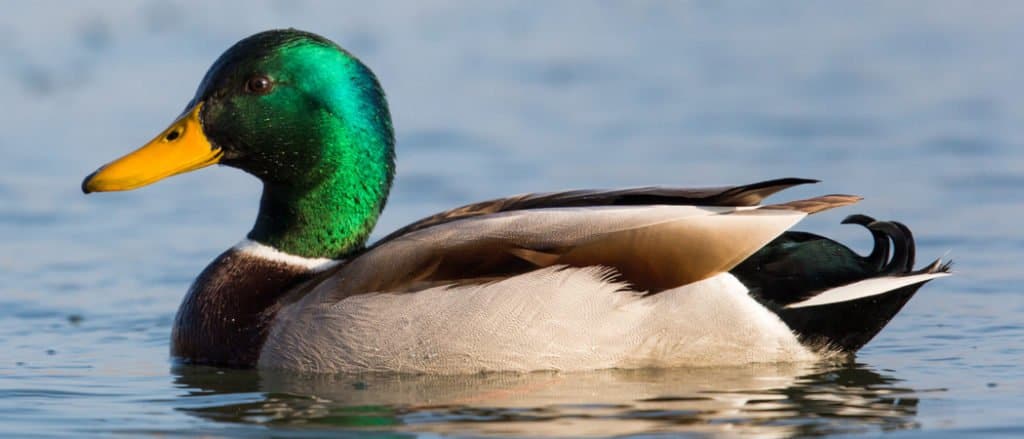
The mallard (pictured) is known for its green head feathers.
©Pascal Halder/Shutterstock.com
2. Magpie
Classification: Pica pica
The magpie is an eye-catching and perceptive bird that inhabits many parts of the United States. It is a medium-sized bird with a wingspan of around 20 to 25 inches and a length of roughly 17 to 20 inches.
The black and white coloring of magpies gives them a unique look. Their belly and shoulder patches are a bright white, and they have a glossy black head, chest, and wings. Their long tail has white patterns on an iridescent black background. They also have powerful beaks and dark, piercing eyes.
Due to their extreme adaptability, these birds may be found throughout the United States in a variety of settings. They can frequently be found in urban settings, parks, gardens, and forests. The opportunistic eating habits of magpies are well known; they consume a wide variety of foods, such as insects, fruits, seeds, small animals, and even carrion.
Magpies stand out because of their exceptional intellect and problem-solving skills. They have a reputation for displaying complicated behaviors including tool usage and social learning. Magpies are renowned for having great nest-building abilities, creating enormous, globular nests from twigs and branches.
The vocalizations of magpies are another distinguishing trait. They make a wide variety of cries, including noisy chattering, melodious warbles, and mimicking of other bird noises.
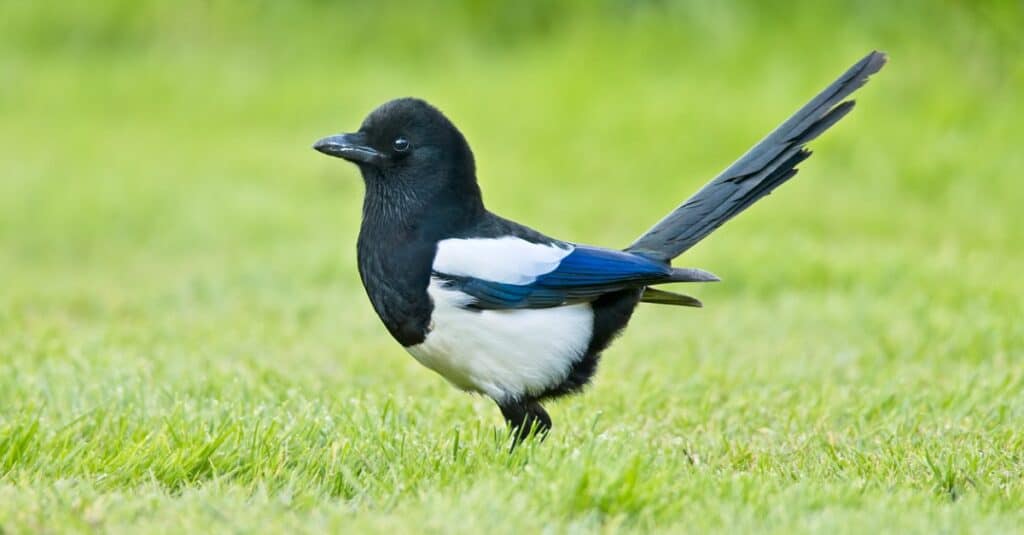
Magpies (pictured) are able to recognize themselves in a mirror while other birds cannot.
©iStock.com/birdsonline
3. Mandarin Duck
Classification: Aix galericulata
The Mandarin duck is a stunningly magnificent and widely recognizable species of duck that is only found in select parts of the United States and East Asia. It is a medium-sized duck with a wingspan of around 24 to 28 inches and a length of roughly 16 to 20 inches.
The Mandarin duck has stunningly colorful and detailed plumage. A deep orange-brown breast, white belly, and a dark green head with a red beak and a protruding crest are just a few of the striking hues the male displays. Its back is covered in complex black, brown, and white designs, while its wings are decorated with a mixture of metallic blue, purple, and green. The female Mandarin duck, on the other hand, is more subdued in appearance with a gray-brown body and a pronounced white eye ring.
The Mandarin duck, which is originally from East Asia, has been brought to several areas of the United States, mostly in the northeast. It lives in forests with ponds, lakes, and slowly flowing rivers. The species is known to favor environments with plenty of vegetation for nesting and shelter.
The Mandarin duck is very distinctive because of its alluring appearance. It is frequently regarded as one of the most stunning ducks in the entire world. It differs from other duck species due to its vivid and elaborate plumage, especially in the case of the male.
The Mandarin duck’s distinctiveness has also been enhanced by its distinctive cultural importance and appeal among bird lovers. It is frequently portrayed in literature and art as a representation of beauty and elegance.
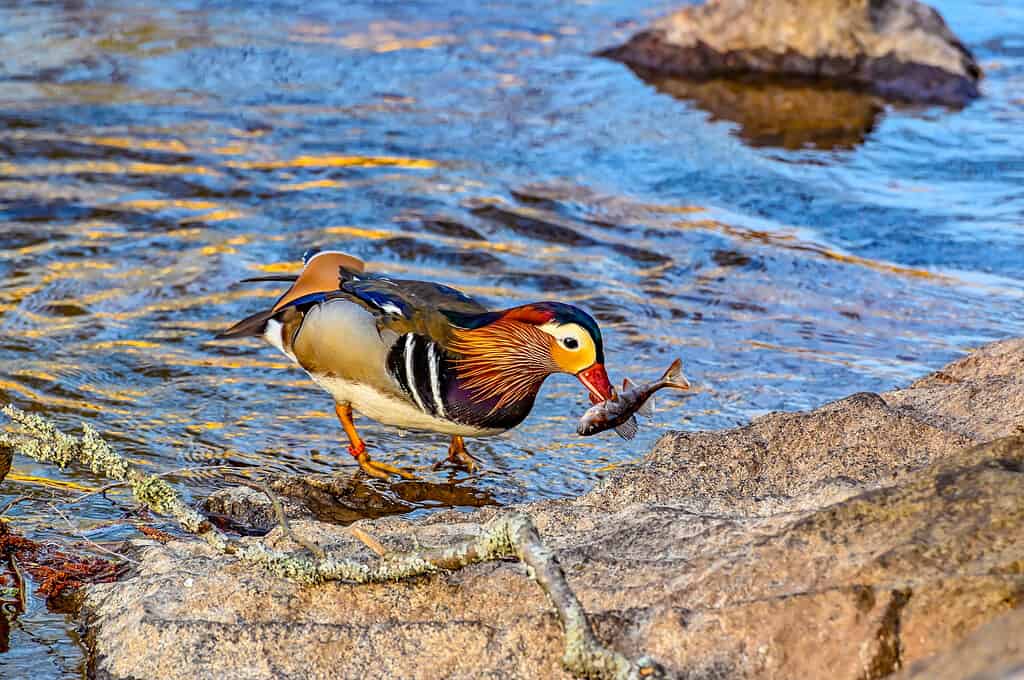
Mandarin ducks (pictured) are excellent fishers.
©iStock.com/Jonas Rönnbro
4. Marabou Stork
Classification: Leptoptilos crumeniferus
The Marabou stork is a large, distinctive bird that has a very recognizable look. It is a large species, standing between 60 and 70 inches tall and with wingspan between 118 and 139 inches.
The Marabou stork has a very unique appearance. It has mostly white feathers and a reddish, wrinkled, featherless head and neck. The bill is large, thick, and bent downward, and the neck is lengthy. Its big, webbed feet are attached to long, strong legs. Overall, it has an unpolished and rather monstrous aspect.
This species of stork is spread throughout Africa, including the Sahel, the Nile Valley, and areas of southern Africa. It prefers areas close to water, such as marshes, swamps, lakes, and rivers. Marabou storks are able to adapt to a variety of habitats since they are frequently spotted in wide savannahs, landfills, and urban areas.
The eating habits of the Marabou stork are distinctive as well. It is a scavenger and opportunist that has been observed eating a variety of foods, including carrion, fish, small animals, reptiles, and even trash. This species has evolved to coexist with people and frequently congregates in huge numbers in close proximity to human settlements or locations with an abundance of food supplies.
The Marabou stork’s nesting habits are another interesting feature of this animal. It often builds its big, disorganized nests of sticks in trees close to sources of water. These nests house several birds and act as communal roosting places.
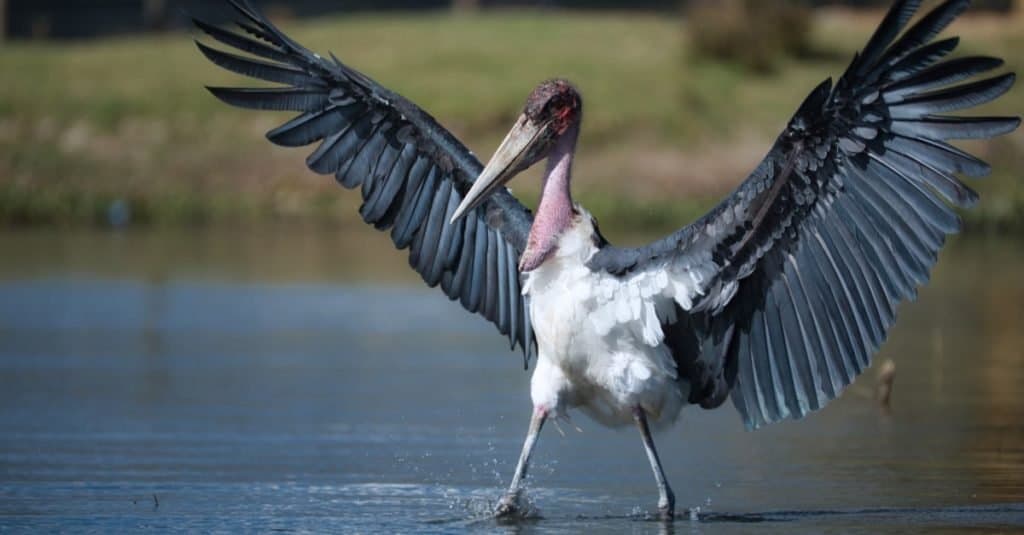
Marabou storks (pictured) have a rather intimidating appearance.
©Blount Photography/Shutterstock.com
5. Marsh Harrier
Classification: Circus aeruginosus
One fascinating species of raptor that may be found in some parts of the United States is the marsh harrier. It is a medium-sized bird of prey that ranges in size from 18 to 24 inches in length and 42 to 51 inches in wingspan.
The marsh harrier has a striking sexual dimorphism look. The remarkable plumage of adult males has a body that is primarily pale grey with black wingtips and spots. They have hooked beaks, pale heads, and golden eyes. The deeper brown underparts and rufous heads of females and young birds are streaked. Long, wide wings and a long tail are shared by both sexes.
The marsh harrier is typically found in marshy settings, as its name indicates. It favors tall vegetation along the shore, reed beds, and wetlands. Select areas of the United States, including the Great Lakes, the Northeast, and portions of the Pacific Northwest, are where these birds can be found.
The marsh harrier hunts differently than other birds of prey. It is a crafty predator, swooping low over wetlands and marshes in pursuit of prey. Small animals, birds, amphibians, and occasionally insects and reptiles make up its main diet. This raptor is well recognized for its distinctive hunting style, which entails flying low and using its keen vision and hearing to find food in the thick undergrowth.
The marsh harrier also demonstrates a distinctive breeding habit. It builds its nests on the ground or in high foliage, typically close to water. As a lone nester, it can maintain extensive territories in pairs.
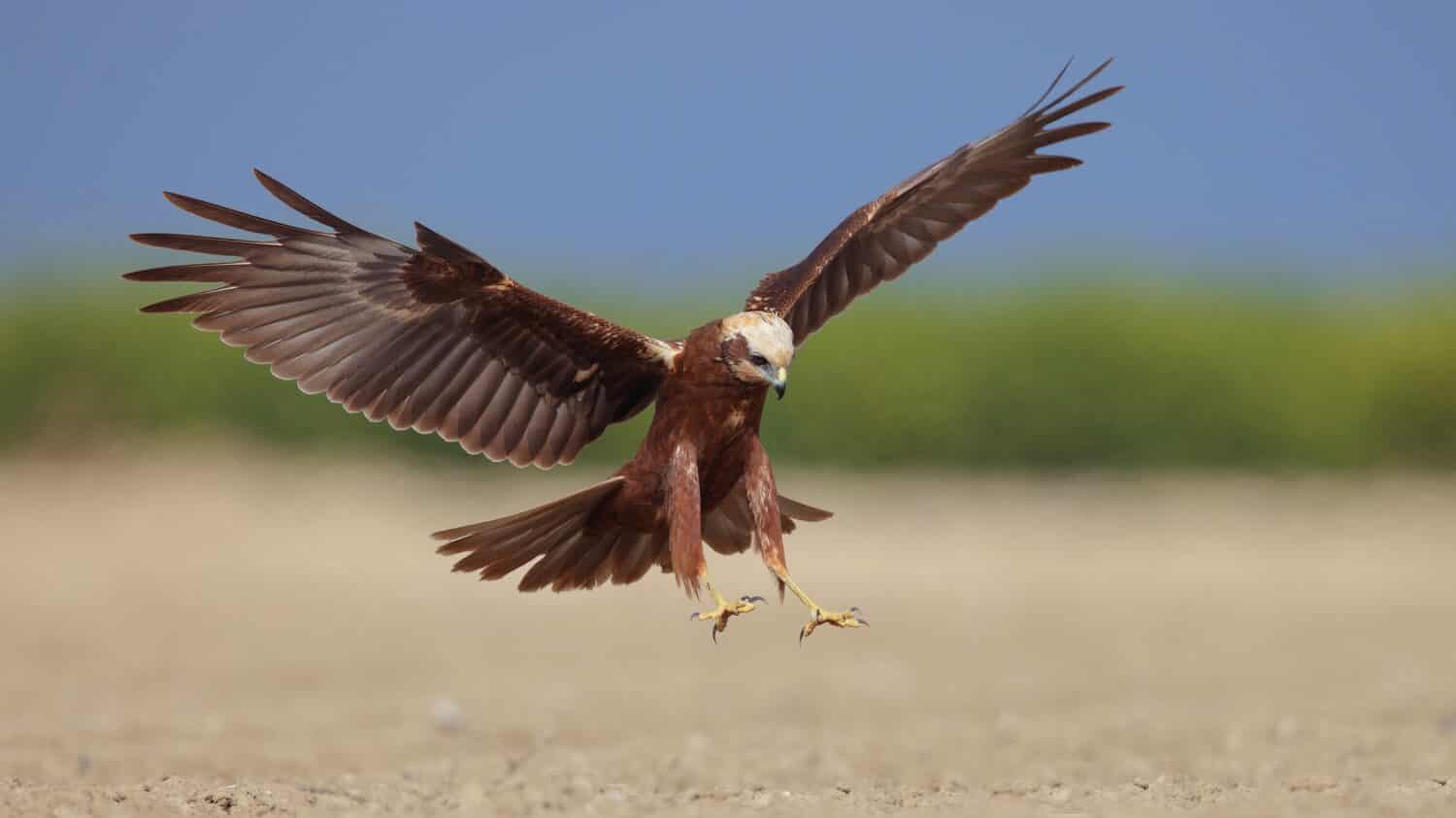
The western marsh harrier flies low and uses its stellar eyesight to spot its food.
©leventgoksoy/Shutterstock.com
6. Meadowlark
Classification: Sturnella spp.
The meadowlark is a mesmerizing songbird species that may be found throughout the United States. It is a medium-sized bird with an average length of eight to 11 inches and a wingspan of 13 to 16 inches.
Meadowlarks stand out from other songbirds thanks to their distinctive look. Their tail is rather short, and their body is robust. Their underparts are a bright yellow, while their top parts are mostly brown with black stripes. The breast of meadowlarks is patterned in a stunning black V shape, with white borders separating it from the yellow belly. They have an eye stripe that is bright yellow and a tall, pointed beak.
Prairies, meadows, and agricultural fields are among the grassland areas where these birds are most commonly found. They flourish in broad spaces with thick grass and sporadic clumps of trees or bushes. Meadowlarks are well renowned for their enchanting songs, which they employ to protect their lands and entice mates.
The meadowlark is special because it can imitate the sounds of other birds and even machinery. They showcase their adaptability and diversity by including a broad range of vocalizations in their tunes. Their call repertoire becomes more intricate and varied as a result of this mimicking.
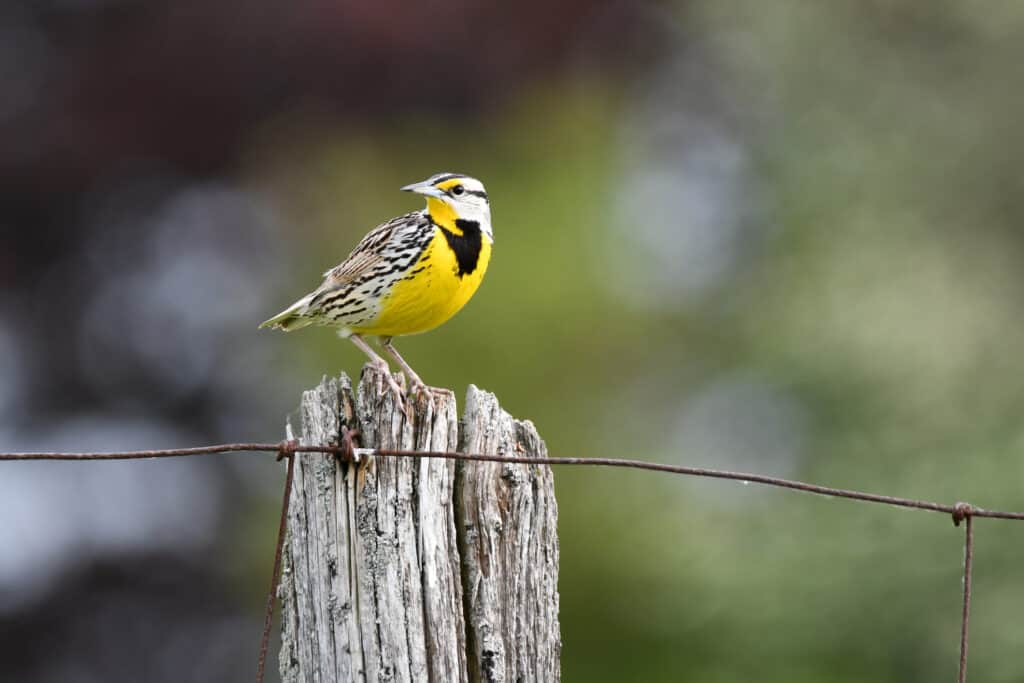
The meadowlark (pictured) is an iconic and beautiful songbird in the United States.
©iStock.com/Carol Hamilton
7. Magellanic Penguin
Classification: Spheniscus magellanicus
One fascinating bird that may be found in South America is the Magellanic penguin. It measures around two feet in height and weighs between eight and 14 pounds. The Magellanic penguin has a distinctive look, with a black back and head, a white belly, and a white stripe across its breast. It has pink skin around its eyes and a black beak. These penguins may be seen living in vast breeding colonies in rocky coastal locations along the shores of Argentina, Chile, and the Falkland Islands. Their streamlined body and webbed feet allow them to swim well and cruise the water in quest of food. They are quite well-adapted to a marine lifestyle.
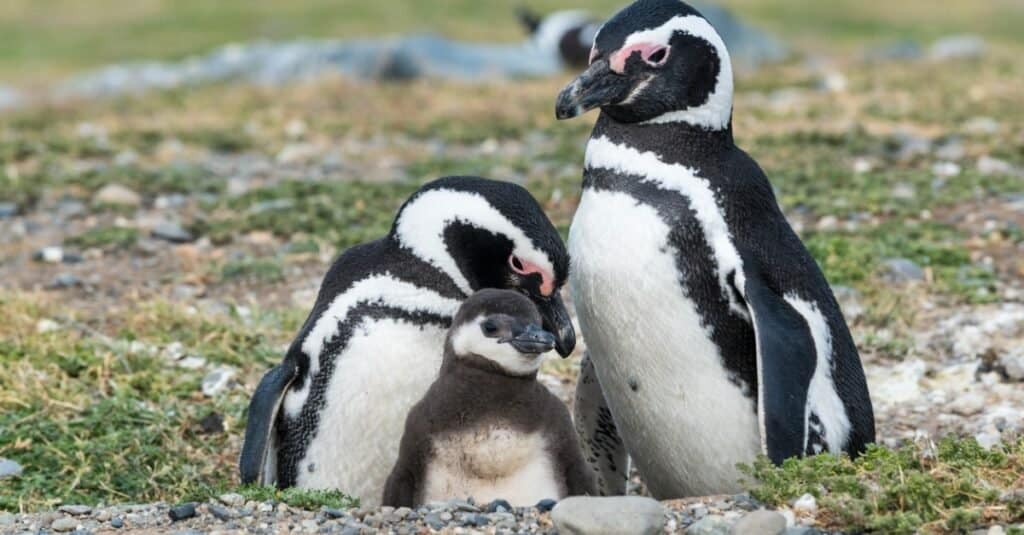
Magellanic penguins (pictured) typically mate for life.
©iStock.com/Sergdid
8. Mockingbird
Classification: Mimus spp.
The intriguing mockingbird is a widespread bird species in the United States. Its length is around eight to 10 inches and its wingspan is about 12 to 15 inches. Mockingbirds have grayish-brown upperparts and white underparts. White patches on their wings are visible when they are flying. They have thin beaks and lengthy tails.
Mockingbirds are renowned for their tremendous vocal range and variety. They are excellent mimics, copying numerous environmental noises as well as the songs and cries of other bird species. They have a distinctive melodic repertoire because of this skill.
In the United States, these birds may be found in a range of habitats, including woodlands, savannas, suburbs, and even city parks and gardens. As long as there is an abundance of food available, they are very adaptable and may flourish in many settings.
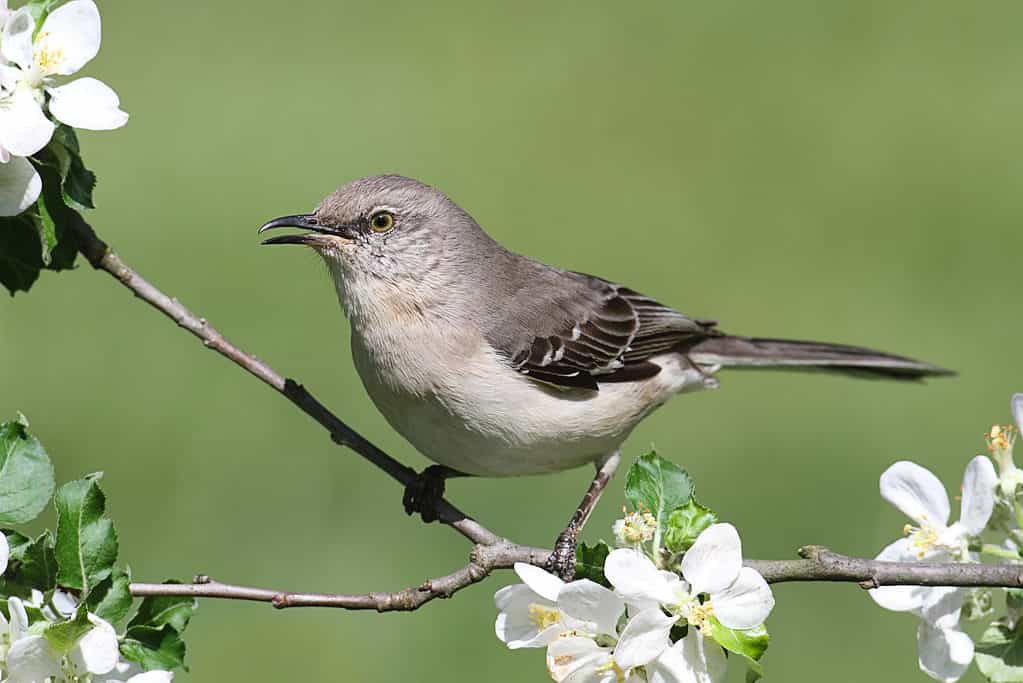
Mockingbirds (pictured) are one of the most adept mimic bird species in the world.
©Steve Byland/Shutterstock.com
9. Motmot
Classification: Momotus spp.
Another fascinating bird species on our list of birds that start with M can be seen in some parts of the Americas. The motmot boasts length ranges from 17 to 20 inches, and its wingspan is between 22 and 24 inches.
Motmots have an exceptional and eye-catching look. Mostly green in color, they feature a distinctive turquoise-blue crown and a black mask covering their eyes. Their long, graduated tails are shaped like a racket, with two center tail feathers that are lengthened and have spherical tips.
In Central and South America’s tropical and subtropical woods, these birds can be found in abundance. Countries like Mexico, Belize, Costa Rica, and some of Brazil are home to them. Usually found in the medium to lower levels of the forest canopy, motmots forage for insects, tiny reptiles, and fruits while perched on trees.
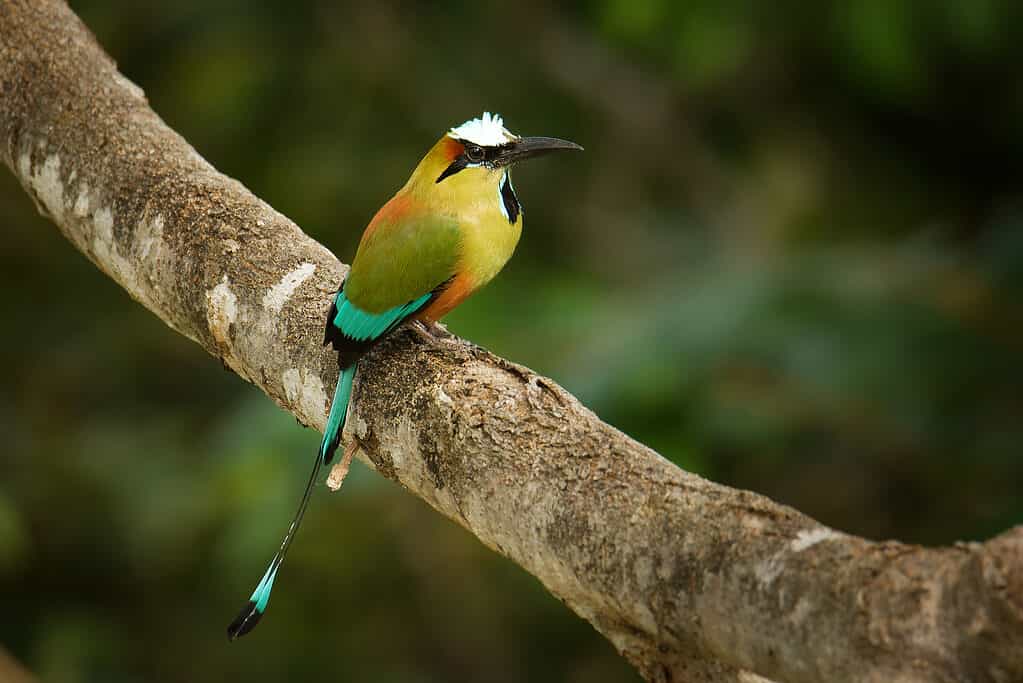
The turquoise-browed motmot (pictured) is just one of several species of motmot.
©iStock.com/phototrip
10. Mountain Bluebird
Classification: Sialia currucoides
North America is home to the magnificent mountain bluebird. It is around six to eight inches long, with a wingspan that ranges from nine to 12 inches.
Mountain bluebirds are colorful birds. The males’ underparts are either pale blue or white, while their backs, wings, and heads are all covered with sky-blue plumage. They have black eyes and a thin bill. The hue of females is a little bit duller, and they have more grey tones on their top regions.
In North America’s hilly terrain, these birds are most commonly seen in open spaces like meadows, fields, and high-elevation habitats. They are frequently observed in the western region of the country, in places like Montana, Idaho, and Colorado.
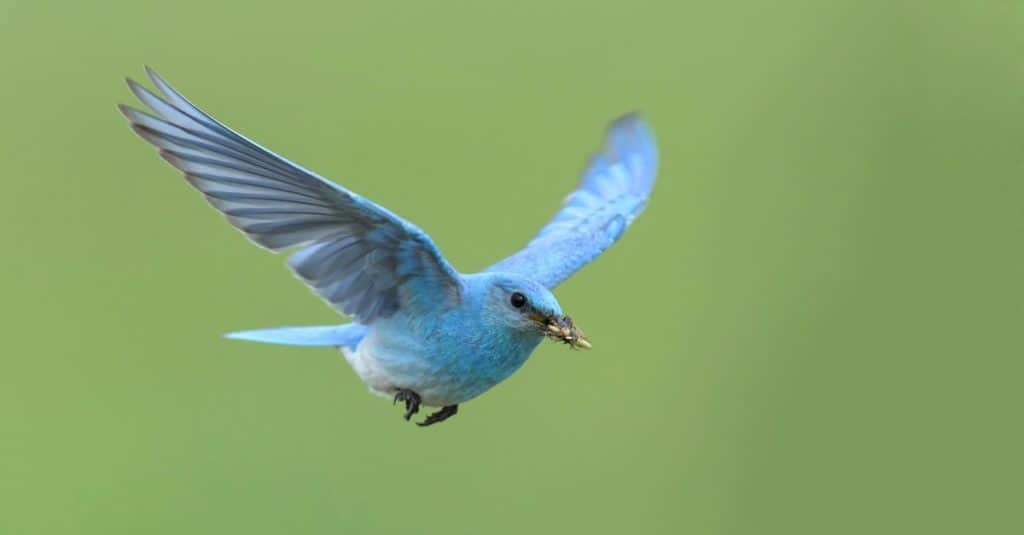
The mountain bluebird (pictured) is known for its beautiful baby blue coloration.
©Agami Photo Agency/Shutterstock.com
The Largest Bird That Starts M
The Marabou stork, scientific name Leptoptilos crumeniferus, is the largest bird that starts with M. The Marabou stork is a huge bird that may grow as tall as five feet and has a wingspan of around 8.5 to 10 feet. It has a large, broad beak and enormous wings. These storks may be seen in some areas of Africa. They are renowned for their scavenging habits and they frequently feed on waste and carrion.
The Fastest Bird that Starts with M
The Merlin, also known as Falco columbarius, is the fasted bird that starts with M. The Merlin is a small species of falcon renowned for its grace and quickness in flight. In its hunting dives and pursuit of prey, it may reach speeds of 60 to 65 miles per hour. The Merlin is renowned for its lightning-fast and deft aerial movements, which enable it to pursue and catch smaller birds mid-flight.
More Amazing Birds That Start With M
| Name | Classification |
|---|---|
| Magnolia Warbler | Setophaga magnolia |
| Malachite Kingfisher | Corythornis cristatus |
| Marbled Murrelet | Brachyramphus marmoratus |
| Marbled Godwit | Limosa fedoa |
| Masked Booby | Sula dactylatra |
| Monk Parakeet | Myiopsitta monachus |
| Montezuma Oropendola | Psarocolius montezuma |
| Mountain Quail | Oreortyx pictus |
| Mountain Plover | Charadrius montanus |
| Mourning Warbler | Geothlypis philadelphia |
The photo featured at the top of this post is © Roel van Moorsel/Shutterstock.com
Thank you for reading! Have some feedback for us? Contact the AZ Animals editorial team.







